Timber Castles |
|
| These are the earthwork and timber castles of the motte and
bailey or ringwork form which where the vast majority of castles of the early
conquest period, of the Marches in the 11th and 12th centuries and of the period
during the reign of Stephen known as the Anarchy. They could be fairly
short lived, although some such castles survived for centuries, with the timber
buildings and defences being replaced on occasions sometimes in timber and
sometimes in masonry (Alderton
Castle in Northamptonshire was shown in a Time Team excavation to have been
built about 1070 and to still have been having high status visitors in the C15-a
fine piece of enamels horse harness being found in the gatehouse). Some of the
smaller low mottes may have been adapted into moated manor houses, whilst others
where abandoned and replaced by manor houses of a more comfortable and domestic
nature. Timber castles varied greatly in size with some being massive constructions
clearly deserving the term castle, whilst other were small mounds of minor knights
and had a similar size, function and social status as the later pele towers.
These small mottes are called 'castle' but this could be considered a rather
obtuse use of the term. In practice some, possibly many, timber castles may have been revetted in dry stone or even have been revetted with timber walls plastered, limewashed and painted with mock masonry lines. |
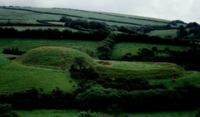 |
| Go to Timber Castle listing for England |
|
Masonry Castle |
|
| These include castles designed from the outset to have masonry defences and timber castles where the fortifications or significant building have been replaced in stone. This includes all the classic castle types such as Shell Keep, Great Tower and bailey, Enclosure, Concentric castles etc. These are the buildings which are what are generally thought of as castles and are well described in many books, web sites etc. Masonry is stonework bounded with mortar or, in a few cases in central Wales (where limestone for mortar did not exist) bedded with clay. A few castles have dry-stone walls, these are listed under earthwork castles, since the dry-stone walling basically requires a similar level of expense and skill as earthwork defences. |  |
|
Go to Masonry Castle listing for England |
|
Siege Works |
|
| Temporary earthwork and timber fortifications built as a secure base and possibly temporary lordly base during the besieging of a castle or town. Siege works are often called siege castles, because of the similarity to earthwork castles, but their residential function was minimal. The distinct tendency to over emphasis military history means where there has been a recorded historical siege or battle earthworks of various sorts may be incorrectly attributed as siege works and particular caution is required when attributing a classification as a siege work. | 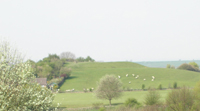 |
|
Go to Siege Work listing for England |
|
Fortified Manor House |
|
| A high status fortified residence not capable of withstanding an army but able to resist an armed band. They are generally moated and have a gatehouse with loops and crenellations. They tend to be sited with much less consideration for tactical and strategic defence and with domestic considerations, such as ease of access, to the fore. The difference between a small castles and a fortified manor house is a subjective one and may well be an artificial division in that for contemporary medieval citizens it may not have existed. David King did not use this term and preferred the term Strong House, since not all fortified high status houses were manorial, but use of his term Strong House has not been widely adopted possible because it is widely used as a synonym for bastle. Such buildings did not require a licence to crenellate, despite some suggestions otherwise, and having a licence to crenellate does not mean a building was certainly fortified. However, all buildings issued a licence to crenellate are recorded under this group since they clearly were at least intended to be [re]constructed in a fortified style. It is clear that a good number of the houses granted licences to crenellate had only very slight defences such as a moat and maybe a thin walled stone gatehouse but otherwise mainly timber buildings. Also recorded under this label are a number of later medieval houses which are not generally considered 'defensive' but which used architectural styles that derived from military function. These houses are sometimes called 'castles of chivalry', they were almost purely residential with the administrative function of the manor often done elsewhere. |
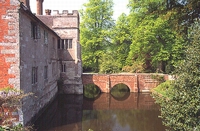 |
|
Go to Fortified Manor House listing for England |
|
Fortified Town House |
|
| Similar in status to fortified manor houses but built with the confines (usually meaning walls) of a town or city. Some of these were the houses of wealthy but relatively low status merchants who could hold considerable sums of precious goods and money at home so would have been strongly built; others were owned by wealthy, but modest social status, civil servants (usually clerics). Because towns are so heavily redeveloped very few of these buildings survive and even contemporary medieval documents only rarely mention them and even less often described these houses. | 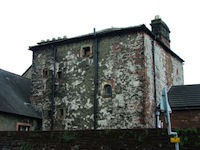 |
|
Go to Fortified Town House listing for England |
|
Palace |
|
| A high status manor house. That is a fundamentally domestic building of a high status person usual a bishop or member of the royal family. Usually more elaborate that a fortified manor but a small bishops palace, such as the one at Lyddington might be quite modest compared to a large fortified manor. All these high status building had some fortifications, if only to keep out thieves, but were probably not seen, even by the contemporary people, as being military buildings. Included in this definition, for the purposes of this site, are Royal hunting lodges. These could vary from sizable buildings, even castles, with courts and gaols (jails) to simple timber building providing short term accommodation. | 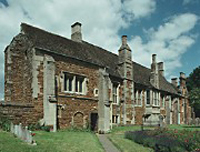 |
|
Go to Palace listing for England |
|
Towerhouse |
|
| The term 'towerhouse' is much used and loosely defined, some authors use it for any type of tower house, including pele towers, and there is, indeed, a continuum in size and status between these buildings. However, Gatehouse more closely defines a Towerhouse as a form of Fortified Manor House where all the accommodation is in one tower, often has a parapet along the top of the tower, turrets and other defensive features. Although the residential buildings form one tower this would usually have had a court of ancillary buildings. This is a high status building, usually of baronial or greater status, and usually a manorial centre. Unsurprisingly for high status buildings, inhabited by lords, these sites are often named castle. | 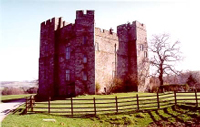 |
|
Go to Towerhouse listing for England |
|
Pele Towers |
|
| Also called peel towers. A form of fortified farmhouse or house
of a significant, but not noble, person, such as a vicar or local knight, built
with some defensive features both for genuine protection from raiding bands
and for social prestige. These can be free-standing towers but are generally chamber (or solar) towers attached
to other, unfortified, buildings. The free standing form is more 'Scottish'
and often later in date and are, in practice, rare. However many peel towers now appear free standing as they have lost their attached timber (or thin walled stone) halls, kitchens and other ancillary buildings. These moderate status building are generally said to
be confined to the North of England, and in the Scottish border area often said to be sited
with some strategic consideration; however, some similar moderate status fortified
buildings, such a forester's lodges, do exist elsewhere. Many authors dislike the use of pele in this sense since one of several original meanings was a temporary military camp. However, Gatehouse considers that the social status and function of these buildings is so significantly different from Towerhouses that a separate category to be needed. There is much to be said for using terms like solar tower which emphasis the fact these buildings were often a small part of a larger complex. However, use of such terms would obscure the social status of these buildings. Part of the reason the term pele tower is disliked is, however, because it emphasises social status something which can cause contention. |
 |
|
Go to Pele Tower listing for England |
|
Bastles |
|
| A form of fortified farmhouse, usually fairly roughly built, rectangular and 15th and 16th century in date (Mainly late 16th century and some continued to be built well into the 17th century) and generally confined to the Northern counties, only occasionally with any active defensive features (such as gun ports). Included because the foundations and scant remains of ruins can be very difficult to differentiate from Pele Towers and because the Bastles were often grouped and were otherwise placed to be of some strategic value in defending against Scottish raids. Philip Dixon makes the point that the term Bastle House probably original most often referred to a higher status rectangular form of 16th century pele tower such as Doddington Bastle whereas the cruder farmhouses were more often called Pelehouses. However, probably to try to avoid confusion with similar names describing different forms the Scottish Royal Commission previous distinction between 'bastle-house' and 'pelehouse' has not been widely adopted and is not now used by RCAHMS. A few very similar type building exist in southern Pembrokeshire and have a similar function against pirates, as would some Cornish Bartons. (Barbary pirates from North Africa were active in Southern English waters in the 15th to 17th centuries and often raided inland kidnapping individuals for slavery or later ransom. Irish pirates were active in the Irish Sea from at least the 3rd century onwards). | 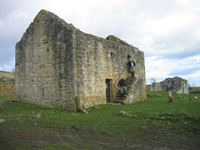 |
|
Go to Bastle listing for England |
|
Artillery Forts |
|
| Fortifications designed specifically for mounting artillery, usually as coastal defence against warships. Vary from large stone structures to small earthwork bulwarks with room for one or two pieces. Although some of the large royal buildings were of high quality with good detail these are actually practical military works. Much early artillery was relatively small and not very powerful and many gun loops in manor houses, town walls etc. would have been for such pieces - probably not even as effective as a modern shotgun although possibly psychologically more effective and, as new and expensive items, certainly impressive and showy. |  |
|
Go to Artillery Fort listing for England |
|
Chain Towers |
|
| A form of harbour defence where a chain is extended across the entry into a harbour or river to prevent access by vessels. The mechanism housing the chain and allowing it to be raised and lowered was housed in a defensive tower, often an artillery fort in its own right. The main function of such chains may actually to have been to control trade and ensure the collection of tolls. | 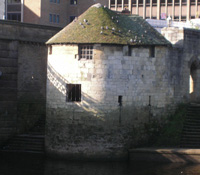 |
|
Go to Chain Tower listing for England |
|
Fortified Ecclesiastical sites |
|
| Monasteries, churches
and granges defended against raids. Monastic communities were made up
of mainly high status people, and that most abbots would be the close relatives of
castle owning lords; monasteries were also often used as stop over residencies
for lords. Much monastic 'fortification' such as gatehouses are actually status
displays rather than really defensive, although scottish raids and peasant
riots did occasionally put such defences to the test. Granges could hold considerable
wealth so defences here were generally practical but also reflect the status
of the parent community. Churches were an important resource for the local
peasant community having many functions beyond spiritual succour; in unsafe
areas like the Marches, this included short-term defence against raiding bands.
Bishop's castles and priest's towers are considered as private residences and
are listed with other castles etc. It is and was commonplace for churches to have towers and to be crenellated. The symbol of secular lordship, the crenellated tower, derived from the responsibilities of secular lordship to defend the community were thus appropriated to symbolise spiritual dominion. It should also be noted that belfry towers have particular structural issues to deal with heavy moving and vibrating bells and need to be substancial for these reasons, particularly in areas where the quality of mortar was poor. |
 |
|
Go to Fortified Ecclesiastical sites listing for England |
|
Urban Defences |
|
| Town walls, banks and gates. Those built by the Romans, Anglo-Saxons or Danes are mentioned if they were maintained, at least partly, during the period 1000-1600. As with most fortifications of the period these were not simply defensive but reflected social status. Ambitious town leaders would petition for and build walls for the personal and civic kudos. Walls and ditches, or sometimes just isolated gates, also regulated trade and made collection of taxes easier. Some villages, in vulnerable areas, had simple defences of ditches to deter cattle raiders and 'wolves' (Although it is doubtful wolves were a significant threat, to any community at any time, they were believed to be a threat and had enormous psychological power). | 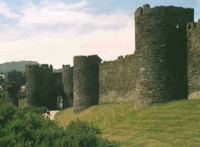 |
|
Go to Urban Defence listing for England |
|
Fortified Bridges |
|
| The narrowness of bridges combined with the fact they cross a long linear obstacle has always made them a place which is defensible. However a number of medieval bridges had gates in gatehouses, either on the bridge itself, or at one end of the bridge, which made these bridges fortified. Some also had drawbridges, although in some cases these may have actually been raisable bridges to allow masted vessels to pass under the bridge. In practice it may be these gates were mainly gates to control traffic and ease the collection of tolls and many bridges had simple bar gates for such a purpose. A number of bridges also had chapels or even hospitals (probably in the medieval sense of visitors lodging houses) on them which, again, may have had a role in toll collection. | 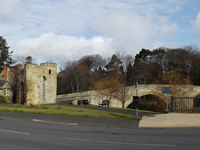 |
|
Go to Fortifed Bridge listing for England |
|
Linear Defences and Dykes |
|
| A number of dykes of medieval date exist in the
North of England and may represent a defence against Scottish raids and/or mark out boundaries. There was
a set of trenches along the coast forming late medieval coastal defences most notably the Downs beach line. As with all fortification such defences can only be of military effectiveness if garrisoned with a force capable of responding to attackers, when they can have a role in delaying an attacking force, particularly one loaded down with booty and livestock. Otherwise such boundary markers must function mainly symbolically. |
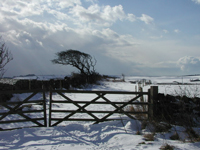 |
|
Go to Linear Defences and Dykes listing for England |
|
Unknown or uncertain |
|
|
Sites which are lost were probable timber castles, other sites are doubtful mentions
of possible fortifications and some are just not clear from the available description. |
|
|
Go to Unknown or uncertain listing for England |
|